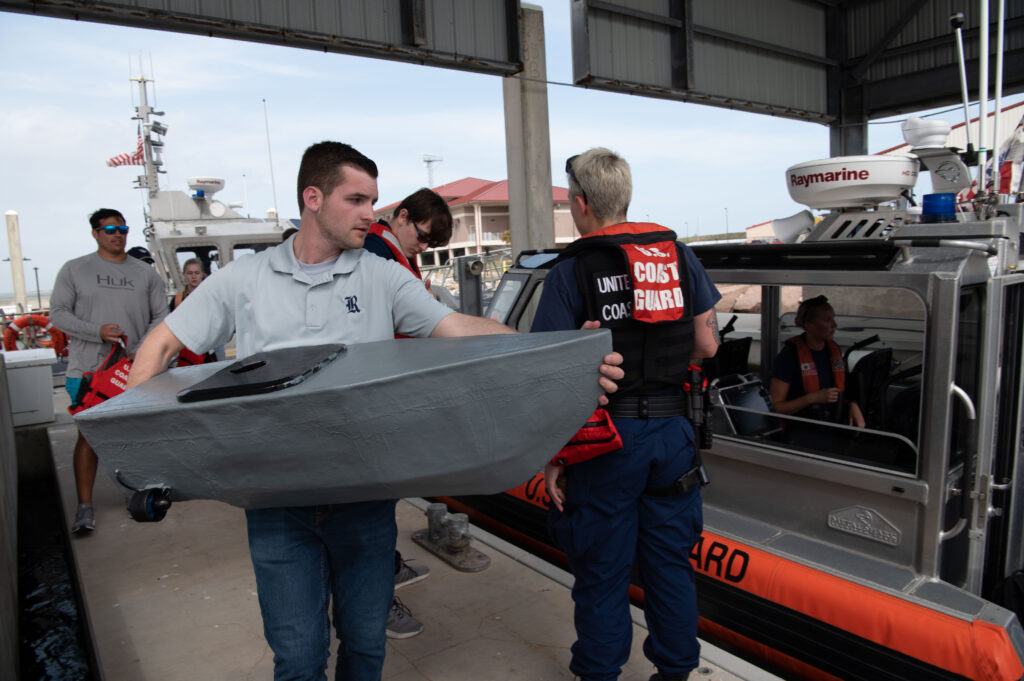
GALVESTON, Texas — A unique student project is helping the Coast Guard find small and hard to detect unmanned autonomous surface vessels that might be used to transport drugs into the U.S.
Several USVs have been recovered attempting to transit drugs across the maritime border with Mexico and into California. The boats can carry about 90 pounds of cargo, which could be illegal narcotics or other hazardous cargo.
To learn how these boats might be detected by sensors, the Coast Guard engaged the National Security Innovation Network, a Department of Defense office which collaborates with major universities and the venture community to develop solutions that drive national security innovation. With Coast Guard Sector San Diego as the project sponsor, NSIN capstone students at San Diego State University and Rice University in Houston, Texas, have been prototyping boats this semester.
Four USVs have been seized by federal law enforcement authorities in Southern California. The first was found in March 2018, another in December 2020, and two more in February and March of 2021, suggesting a high likelihood there are many more that have gone undetected.
The vessels are three to four feet long and have a freeboard of just seven inches. They navigate autonomously and can travel for about 66 nautical miles at a speed of about 2.5 knots.
According to information provided by the U.S. Coast Guard, their above-water profile is minimal, which makes it hard for existing maritime domain awareness tools and detection capabilities to see them. Not only are they capable of reaching uninhabited shores with illegal narcotics, they could also penetrate defense layers surrounding coastal and harbor-based high value targets — military bases, power plants, or critical infrastructure — with explosives.
The purpose of the NSIN project is to improve coastal surveillance, detection and interdiction capabilities to threats posed by this evolving threat. The students were tasked with designing and testing a USV with similar characteristics to ones previously detected, and to test and demonstrate detection using an existing surveillance tool.
Students from Rice University built a replica boat that was “reverse engineered” and demonstrated in Galveston, Texas, March 29-30 to see how a special high-resolution and wide-angle camera called the WAV Surveillance System could be used to detect the boat in realistic conditions.
“The Rice student team designed and constructed a model that can be used to test existing systems leading to enhanced capabilities and also providing a roadmap for others to replicate similar platforms to routinely test their own system,” said Fritz Kuebler, Rice University’s Office of Research NSIN program director.
“This project has been underway for about two months and has involved extensive research, design and testing by the student team with regular interaction from the project sponsor,” Kuebler said.
“Coast GuardSector Houston-Galveston has been an ardent supporter of this project and provided assets to assist with the testing including deploying and recovering the [unmanned vessel] on the testing days, and coordinated participation with local maritime security stakeholders,” said Kuebler.
WAV is a long-range video surveillance solution for homeland security applications and other situations that require persistent visual-domain awareness of very wide areas. It was designed by and developed by Innovative Signal Analysis Inc., of Richardson, Texas, and has both commercial and military applications. WAV is uniquely able to function as both a wide-angle and zoom camera at the same time, and is currently deployed in San Diego Harbor.
“The WAV surveillance system is capable of finding these low probability of intercept targets, because it can survey a wide area, 90-degrees, at a high resolution at a higher refresh rate than a standard point-to-zoom camera,” said Jonathan Ray of Innovative Signal Analysis of Richardson, Texas, the company that makes WAV. “We take advantage of these components in our algorithms to build a history of detects of the object to improve location accuracy and object detection confidence.”
WAV’s imagery led to the eventual discovery of the autonomous USVs.
“This project highlights the value of bright, dedicated STEM students working with national security experts to make a real difference,” Kuebler. “It also serves as a proof of concept and example for how creative thinking and new methodologies advances broader U.S. strategic objectives regarding maritime security and the value of this critical infrastructure.”
- A Day to Remember - September 11, 2023
- Indo-Pacific Maritime Security Exchange will examine emerging capabilities and capacity - July 12, 2023
- Cold Waters Spark Warm Relationship - April 20, 2023






